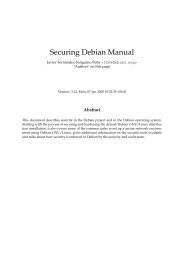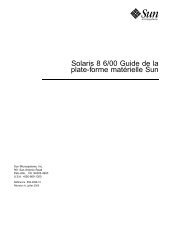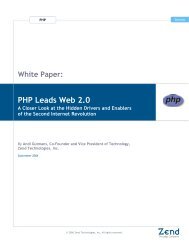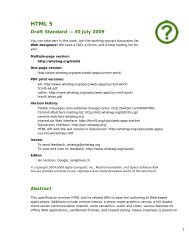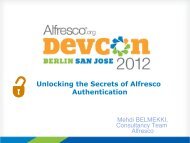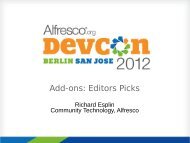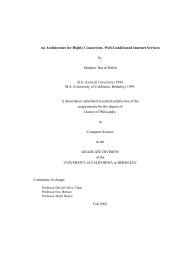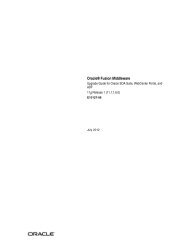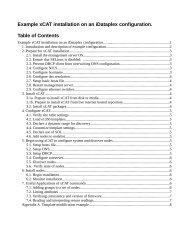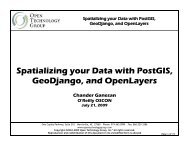Slackware Linux Basics - Huihoo
Slackware Linux Basics - Huihoo
Slackware Linux Basics - Huihoo
You also want an ePaper? Increase the reach of your titles
YUMPU automatically turns print PDFs into web optimized ePapers that Google loves.
Chapter 2. An introduction to<br />
<strong>Slackware</strong> <strong>Linux</strong><br />
2.1. What is <strong>Linux</strong>?<br />
<strong>Linux</strong> is a UNIX-like kernel, which is written by Linus Torvalds and other developers. <strong>Linux</strong> runs on many different<br />
architectures, for example on IA32, IA64, Alpha, m68k, SPARC and PowerPC machines. The latest kernel and<br />
information about the <strong>Linux</strong> kernel can be found on the <strong>Linux</strong> kernel website: http://www.kernel.org.<br />
The <strong>Linux</strong> kernel is often confused with the GNU/<strong>Linux</strong> operating system. <strong>Linux</strong> is only a kernel, not a complete<br />
operating system. GNU/<strong>Linux</strong> consists of the GNU operating system with the <strong>Linux</strong> kernel. The following section<br />
gives a more extensive description of GNU/<strong>Linux</strong>.<br />
2.2. What is GNU/<strong>Linux</strong>?<br />
In 1984 Richard Stallman started an ambitious project with the goal to write a free UNIX-like operating system. The<br />
name of this system is GNU, which is an acronym of “GNU's Not UNIX”. Around 1990, all major components of<br />
the GNU operating system were written, except the kernel. Two years earlier, in 1988, it was decided that the GNU<br />
project would use the Mach 3.0 microkernel as the foundation of its kernel. However, it took until 1991 for Mach 3.0<br />
to be released under a free software license. In the the same year Linus Torvalds started to fill the kernel gap in the<br />
GNU system by writing the <strong>Linux</strong> kernel. GNU/<strong>Linux</strong> thus refers to a GNU system running with the <strong>Linux</strong> kernel.<br />
The GNU kernel, named “HURD” was still under development when this book was written, and is available as the<br />
GNU/HURD operating system. There are some other kernels that are ported to the GNU operating system as well. For<br />
instance, the Debian project has developed a version of the GNU operating system that works with the NetBSD kernel.<br />
2.3. What is <strong>Slackware</strong> <strong>Linux</strong>?<br />
<strong>Slackware</strong> <strong>Linux</strong> is a GNU/<strong>Linux</strong> distribution, which is maintained and developed by Patrick Volkerding. A<br />
distribution is a coherent collection of software that provides a usable GNU/<strong>Linux</strong> system. Volkerding started using<br />
GNU/<strong>Linux</strong> because he needed a LISP interpreter for a project. At the time the dominant GNU/<strong>Linux</strong> distribution was<br />
Softlanding System <strong>Linux</strong> (SLS <strong>Linux</strong>). <strong>Slackware</strong> <strong>Linux</strong> started out as a private collection of Volkerding's patches<br />
for SLS <strong>Linux</strong>. The first publicly available <strong>Slackware</strong> <strong>Linux</strong> release was 1.0, which was released on July 16, 1993.<br />
In contrast to many other GNU/<strong>Linux</strong> distributions, <strong>Slackware</strong> <strong>Linux</strong> adheres to the so-called KISS (Keep It Simple<br />
Stupid) principle. This means that <strong>Slackware</strong> <strong>Linux</strong> does not have complex graphical tools to configure the system. As<br />
a result the learning curve of <strong>Slackware</strong> <strong>Linux</strong> can be high for inexperienced GNU/<strong>Linux</strong> users, but it provides more<br />
transparency and flexibility. Besides that you get a deeper understanding of GNU/<strong>Linux</strong> with no-frills distributions<br />
like <strong>Slackware</strong> <strong>Linux</strong>.<br />
Another distinguishing aspect of <strong>Slackware</strong> <strong>Linux</strong>, that also “complies” with the KISS principle, is the <strong>Slackware</strong><br />
<strong>Linux</strong> package manager. <strong>Slackware</strong> <strong>Linux</strong> does not have a complex package manager like RPM or dpkg. Packages are<br />
normal tgz (tar/gzip) files, often with an additional installation script and a package description file. For novice users<br />
tgz is much more powerful than RPM, and avoids dependency problems. Another widely known feature of <strong>Slackware</strong><br />
<strong>Linux</strong> is its initialization scripts. In contrast to most other GNU/<strong>Linux</strong> distributions <strong>Slackware</strong> <strong>Linux</strong> does not have a<br />
directory for each runlevel with symbolic links to services that have to be started or killed in that runlevel. It uses a<br />
simpler approach in which you can enable or disable services by twiddling the executable bit of an initialization script.<br />
The packages in <strong>Slackware</strong> <strong>Linux</strong> are compiled with as little modifications as possible. This means you can use most<br />
general GNU/<strong>Linux</strong> documentation.<br />
7



